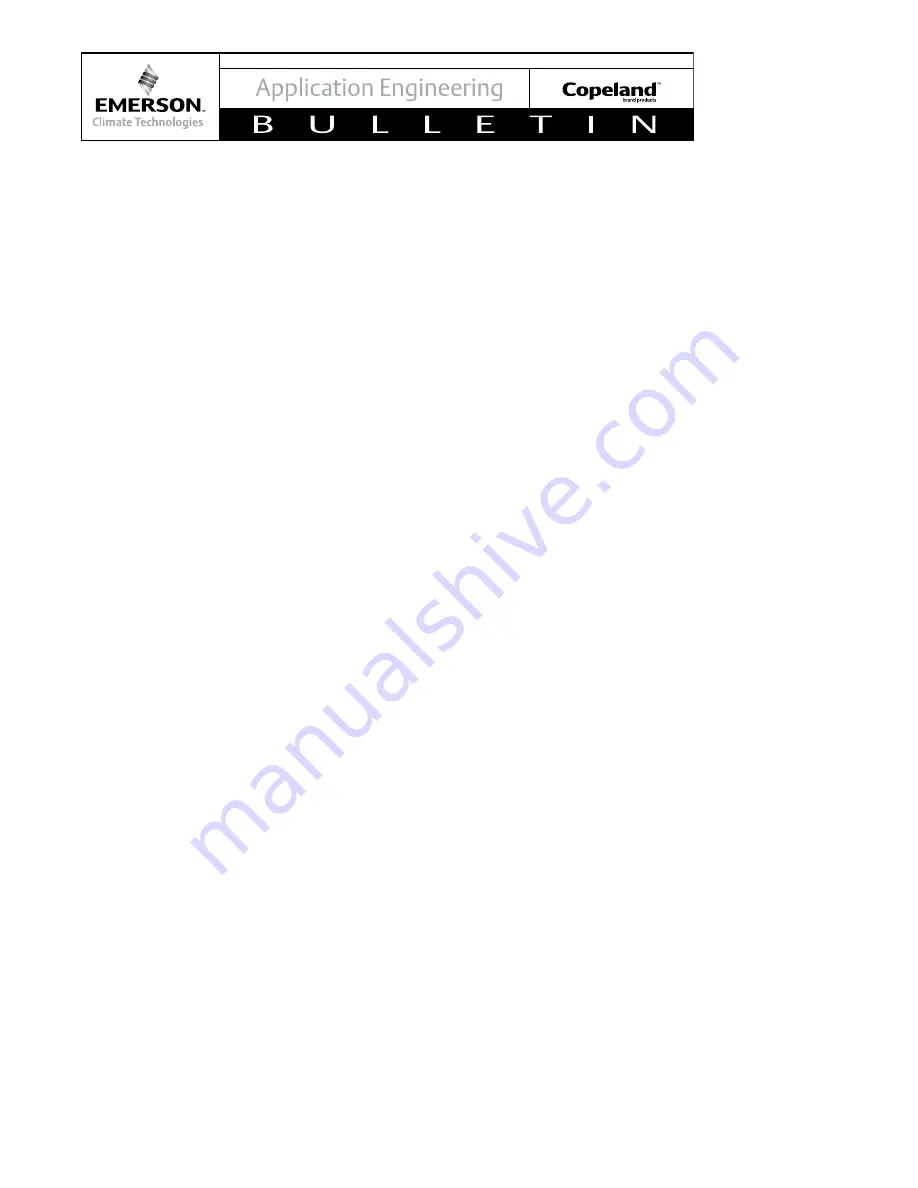
8
© 2016 Emerson Climate Technologies, Inc.
AE4-1402 R4
to ensure that refrigerant velocities are high enough
at low speeds to ensure oil return to the compressor.
At the same time, high refrigerant velocities at high
speed operation can result in excessive pressure drop
and loss of system efficiency. A careful evaluation
and compromise in pipe sizing will likely have to be
settled upon. A compressor sample with a sight-tube
for monitoring the oil level should be used during
system development to ensure an adequate oil level is
maintained at operating conditions and speeds.
If testing shows a gradual, continuous loss of oil in
the compressor sight-tube over long run cycles at low
speed, an oil boost cycle should be incorporated into
the system logic. An oil boost cycle is accomplished by
ramping the compressor speed up to a higher speed to
increase the refrigerant flow rate to flush or sweep oil
back to the compressor. Frequency and duration of a
recovery cycle depends on many variables and would
have to be determined through testing for each system
type and configuration. A default method could be to
initiate a recovery cycle at regular intervals.
Long Pipe Lengths / High Refrigerant Charge
Some system configurations may contain higher-than-
normal refrigerant charges either because of large
internal coil volumes or long line sets. If such a system
also contains an accumulator then the permanent
loss of oil from the compressor may become critical.
If the system contains more than 20 pounds (9 kg)
of refrigerant, it is our recommendation to add one
fluid ounce of oil for every 5 pounds (15 ml/kg) of
refrigerant over this amount. If the system contains
an accumulator the manufacturer of the accumulator
should be consulted for a pre-charge recommendation.
Other system components such as shell and tube
evaporators can trap significant quantities of oil and
should be considered in overall oil requirements.
Reheat coils and circuits that are inactive during part of
the normal cycle can trap significant quantities of oil if
system piping allows the oil to fall out of the refrigerant
flow into the inactive circuit. The oil level must be
carefully monitored during system development, and
corrective action should be taken if the compressor
oil level falls more than 1.5"(40 mm) below the center
of the sight-glass.
The compressor oil level should
be checked with the compressor 'off' to avoid the
sump turbulence when the compressor is running.
These compressors are available to the OEM with a
production sight-glass that can be used to determine the
oil level in the compressor in the end-use application.
These compressors are also available to the OEM with
an oil Schrader fitting on the side of the compressor to
add additional oil if needed because of long lengths of
piping or high refrigerant charge.
No attempt should
be made to increase the oil level in the sight-glass
above the 3/4 full level. A high oil level is not
sustainable in the compressor and the extra oil will
be pumped out into the system causing a reduction
in system efficiency and a higher-than-normal oil
circulation rate.
Discharge Check Valve
The ZPV063 compressor uses a shutdown valve
located in the discharge fitting. This check valve is not a
low-leak-back check valve and will leak when pressure
differential across the check valve is low.
Suction and Discharge Tube Design
Proper tube design must be taken into consideration
when designing the tubing connecting the variable
speed scroll to the system. The tubing should provide
enough 'flexibility' to allow normal starting and stopping
of the compressor without exerting excessive stress on
the tube joints.
Because the variable speed scroll has a broad
mechanical running frequency range, it will be almost
impossible to avoid all of the natural frequencies that
may exist in the system piping. The system designer
must carefully evaluate these resonant frequency
conditions and either a) avoid them by not allowing the
compressor speed to align with the resonant frequency,
or b) evaluate the risk and life of the piping system when
the compressor is allowed to run at frequencies that
are coincident with natural frequencies of the piping
system. To do part 'b', strain gauging the system piping
is required. For assistance in evaluating strain gauging
results contact Application Engineering.
In order to properly determine if a design is appropriate
for a given application, samples should be tested and
evaluated for stress under various conditions of use
including frequency, load fluctuations, and shipping
vibration. The guidelines above may be helpful;
however, testing should be performed for each system
designed. For further assistance and analysis of test
results please contact Application Engineering.
Compressor Mounting
The ZPV063 compressors have pierced holes in the









































